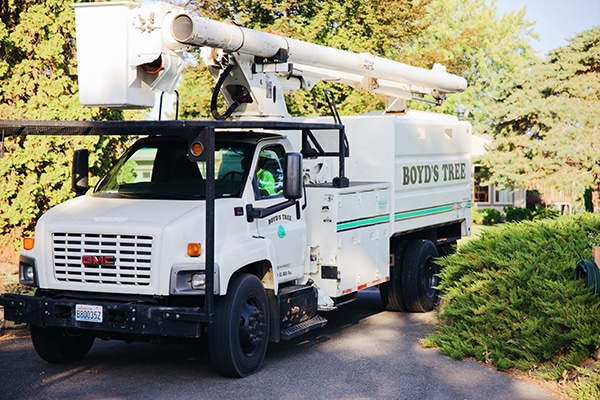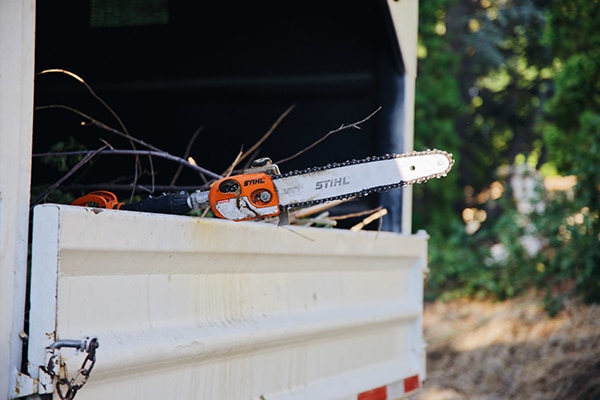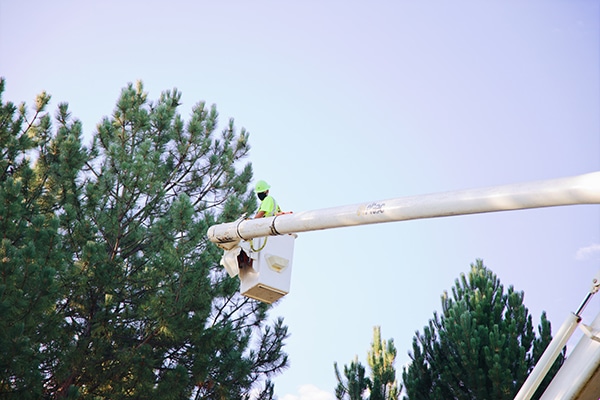Though we often take trees for granted with their unique, eye-catching leaves that give us aesthetic beauty and much-needed shade in the warmer months of the year, when they shed their leaves they appear to us as if they have lost their natural wonder.
The “when” aspect to trees losing their leaves is affected by the amount of daylight and the type of weather occurring.
For instance, if we experience unusual weather, such as a very dry season, then trees could shed their leaves sooner than later. The weather has a significant impact on the timing of leaf shedding.

How Daylight and Weather Influence Trees Losing their Leaves
As the days become shorter, typically around the autumnal equinox, there is less sunlight, and heat, and water for photosynthesis. Photosynthesis uses chlorophyll to provide energy for the tree. When we have fewer hours of sunlight, the chlorophyll content of the leaves decreases, and the green color no longer shields the yellows, oranges, and reds that are in the leaves. That is why we notice bright, radiant autumn tree colors before the leaves fall.
When it comes to timing, the amount of sunlight a tree receives affects leaf shedding. For example, trees with northern exposure typically will change color and lose their leaves earlier than the same types of trees that are close by but receive more hours of sunlight.
Trees react to the length of time they are exposed to sunlight. They will begin to lose leaves when the days are shorter, even if temperatures have not dropped considerably. Different tree species respond to slightly different lengths of days. It is worth noting that a tree living below a streetlight will have its lifecycle disturbed by the light.
Environmental Factors
There are various environmental factors that help to determine when trees will lose their leaves. For instance, the amount of water trees receive, as well as an early or late frost, high winds, and unseasonable temperatures – hot or cold – can change the pattern of leaf loss in deciduous trees.
Why Trees Lose their Leaves
Again, environmental factors significantly impact when trees shed their leaves. In cities, trees experience a variety of man-made stressors like air pollution, salt damage – from home water softeners, and the use of salt to melt snow and ice. They are also negatively affected by industrial pollution, such as heavy metals seeping into the soil and herbicides used to kill weeds and unwanted plants near the roots of the tree.
All of these occurrences will influence the timing for when trees shed their leaves. An example of this is a tree planted adjacent to a busy street will likely lose its leaves sooner than a tree of the same type in a park several miles away.
As with many things in the natural world, tree growth patterns revolve around the sun. After trees detect a decrease in the amount of daylight, they begin to reduce the amount of chlorophyll they produce.
Chlorophyll is the life source for trees. It is the pigment that turns leaves green and is the main producer of energy for nearly all plants. When chlorophyll production ceases, it gets broken down and taken back into the tree. This chlorophyll reduction makes it possible for other pigments that have always been present in leaves, however, not visible because of the overwhelming amount of chlorophyll, to be seen. Their colors are typically yellow, orange, and red.
The process for shedding leaves begins with leaves changing color and then growing a layer of cells between the leaf stem and the tree branch. This layer is known as an abscission layer. This layer stops the delivery of nutrients and water to the leaf and becomes the primary physical reason trees lose their leaves. This abscission layer also aides in protecting this sensitive area of the plant from winter cold and dryness.
The main reason for leaf shedding for a majority of trees is that, with the arrival of winter, it turns cold and dry here in Washington State. Instead of expanding energy to protect these fragile organs, trees shed leaves to conserve resources.
During the winter, water, for all intents and purposes, is not available for most plants. That is because water is in the form of ice, and it isn’t possible for trees to replenish what they lose.
Let Boyd’s Tree Service Help Keep Your Trees Healthy and Thriving
At Boyd’s Tree Service, we are a full-service tree and stump removal business that serves the Tri-Cities and surrounding areas. We pride ourselves on always making sure the trees in our communities are healthy and beautiful.
You’ll find that at Boyd’s Tree Service – comprised of fourth-generation tree men – we provide the most comprehensive tree care. We take pride in enhancing the well-being, beauty and aesthetics of your trees.
If you live in the Tri-Cities and surrounding areas and you would like more information about our tree services or to schedule an appointment, we invite you to call Boyd’s Tree Service at (509) 585-4194.







